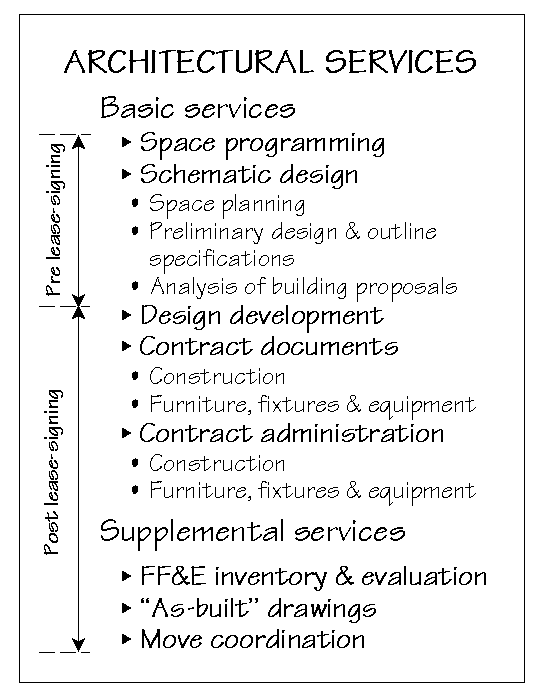The choice of an architect with whom to work on a real estate project is generally dependent upon both subjective and objective elements. The subjective elements embrace such things as how one reacts to the architect's approach and prior work, and how one perceives the future working relationship between the architect and the user. The objective elements usually involve the types of services offered by the architect, as well as the charges associated with those services. While the subjective aspects are very important, we believe the user can deal with those without outside help, and thus they are not addressed in the following discussion. Rather, the discussion concentrates on the identification and evaluation of the objective elements.
Some time ago a client asked us to help him select and retain an architect to become a member of the real estate team that would handle his office space project. We provided him with the names of several firms, all of which had strong practices in the field of office design. He subsequently interviewed three of the firms and requested proposals from each of them. The proposals that were submitted, while similar in scope, were different enough in structure that it was almost impossible to compare them on the basis of the services offered and the associated charges. (It was the old story of trying to compare “apples to oranges.”) Consequently, the client found it difficult to make a final selection.
In order to allow future clients to compare “apples to apples,” we knew that the architects under consideration for any given project would have to be provided with a detailed request for proposal (RFP) to which they could respond. We enlisted the assistance of the three firms which had submitted proposals to our client and developed just such a detailed RFP.
We had two primary goals for the RFP: (1) to provide guidance to the responding architect in describing the services offered and the method of charging for them, and (2) to make it as easy as possible for the architect to prepare a proposal that would give the user all the information required. By building on a format suggested by the American Institute of Architects, and by including a comprehensive listing of all services that any user might desire, we accomplished both goals. Clients who have used the RFP have found it an effective tool for evaluating architectural services and, ultimately, contracting for services with the selected architectural firm. Additionally, the architects who have responded to the RFP have found it to be a simple and effective aid in preparing their proposals.
We provide the RFP to all clients for use as they see fit. Even clients who already know which architect they will be using have found the RFP valuable. By requesting their architect to prepare a proposal based upon the RFP, the client obtains a clear, up-front understanding of just what the charges will be for the various services desired. The chart below highlights the RFP contents.
